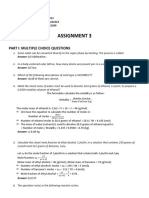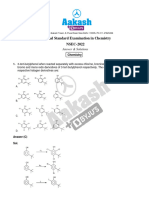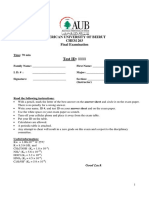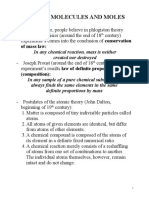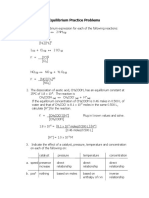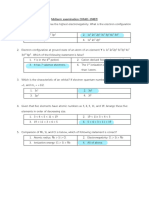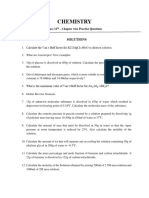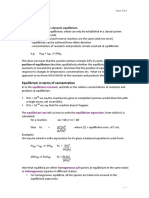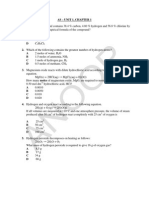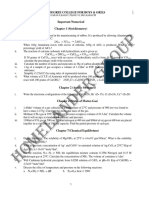142A Practiceexam3 W20KEY
142A Practiceexam3 W20KEY
Uploaded by
Alana Yudha-WrightCopyright:
Available Formats
142A Practiceexam3 W20KEY
142A Practiceexam3 W20KEY
Uploaded by
Alana Yudha-WrightOriginal Title
Copyright
Available Formats
Share this document
Did you find this document useful?
Is this content inappropriate?
Copyright:
Available Formats
142A Practiceexam3 W20KEY
142A Practiceexam3 W20KEY
Uploaded by
Alana Yudha-WrightCopyright:
Available Formats
STEM-Dawgs Workshops – Practice Exam 3 KEY CHEM 142A
These questions are from the online practice exam.
1. Determine the number of electrons transferred in the reaction below by balancing it in acidic medium.
Br- (aq) + MnO4- (aq) → Br2 (l) + Mn2+ (aq)
Find and balance the half reactions: 2Br-(aq) → Br2 (l) MnO4- (aq) → Mn2+(aq)
Add waters balance O: 2Br (aq) → Br2 (l)
- MnO4- (aq) → Mn2+(aq) + 4H2O (l)
+
Add H to balance H: 2Br (aq) → Br2 (l)
- 8H (aq) + MnO4- (aq) → Mn2+(aq) + 4H2O (l)
+
Add e- to both sides to balance the charges: 2Br (aq) → Br2 (l) + 2e
- - 5e- + 8H+(aq) + MnO4- (aq) → Mn2+(aq) + 4H2O (l)
Multiply the half reactions by a multiplier to get the same number of electrons.
5 x [2Br-(aq) → Br2 (l) + 2e-] 2 x [5e- + 8H+(aq) + MnO4- (aq) → Mn2+(aq) + 4H2O (l)]
10e- are transferred between the two half-reactions.
2. According to the concentration in time figure to the
right, what is the balanced chemical equation for this
reaction?
H2 + I2 → 2 HI
3. In a laboratory experiment, several different concentrations of NOBr were decomposed and the rates of
those processes are listed below. Determine the order of the reaction:
2 NOBr (g) → 2 NO (g) + Br2 (g)
[NOBr](mol/L) Rate (mol/L*s) 𝑅𝑎𝑡𝑒1 𝑘[𝑁𝑂𝐵𝑟]1𝑚
=
0.0450 1.62 x 10-3 𝑅𝑎𝑡𝑒2 𝑘[𝑁𝑂𝐵𝑟]𝑚 2
1.62 × 10−3 0.0450 𝑚
0.0310 7.69 x 10-4 =( )
7.22 × 10−5 0.0095
0.0095 7.22 x 10-5 3.1107 = 1.555𝑚
ln 3.1107 = 𝑚 ln 1.555
𝑚 = 1.999 ≈ 2, 2nd order
4. The hydrogen sulfate or bisulfate ion, HSO4- can act as either an acid or a base in water solution. Write
the balanced chemical equation describing HSO4- acting as an acid in water.
Acids donate H+ in water: HSO4- + H2O → SO42- + H3O+
Solutions are available on Canvas.
STEM-Dawgs Workshops – Practice Exam 3 KEY CHEM 142A
5. 525 mL of a 0.300 M solution of sodium carbonate is mixed with 225 mL of a 0.125 M solution of
calcium nitrate. Write the balanced chemical reaction equation describing the reaction when these
solutions are mixed together.
Ca(NO3)2 (aq) + Na2CO3 (aq) → CaCO3 (s) + 2 NaNO3 (aq)
6. Using your balanced reaction and the data provided in 5., calculate the mass of precipitate that forms
when the solutions are mixed together.
Find the starting moles of both species:
Na2CO3 : 0.525 𝐿 × 0.300 𝑀 = 0.158 𝑚𝑜𝑙𝑒𝑠 and Ca(NO3)2 : 0.225 𝐿 × 0.125 𝑀 = 0.0281 𝑚𝑜𝑙𝑒𝑠
The net ionic reaction tells us that there is a 1:1 ratio of Ca2+ to CO32-, therefore, we can just compare
the starting moles to figure out the limiting reactant. Ca2+ will be used up first and makes 0.0281 moles
of CaCO3. Now find the mass of precipitate:
100.08 𝑔
0.0281𝑚𝑜𝑙𝑒𝑠 × = 𝟐. 𝟖𝟏 𝒈
𝑚𝑜𝑙𝑒
7. Using your balanced equation and the data provided in 5., calculate the final concentration of
carbonate in the solution after the reaction.
We know that 0.0281 moles of CO32- reacted. Find the remaining: 0.158 moles – 0.0281 moles = 0.130
moles remain. Divide this by the total volume, which is 0.525 L + 0.225 L = 0.750 L
0.130 𝑚𝑜𝑙𝑒𝑠
[𝐶𝑂32− ] = = 0.173 𝑀
0.750 𝐿
8. A student pipettes 5.00 mL of a 0.225 M NaCl solution into a 100.0 mL volumetric flask. What is the
concentration of the diluted NaCl solution?
Convert mL to L: 5.00 mL = 5.00 x 10-3 L, 100.0 mL = 100.0 x 10-3 L
Calculate moles of NaCl: 5.00 x 10-3 L(0.225 mol/L) = 1.13 x 10-3 mol NaCl
Calculate new concentration: 1.13 x 10-3 mol NaCl/100.0 x 10-3 L = 1.13 x 10-2 M
Solutions are available on Canvas.
STEM-Dawgs Workshops – Practice Exam 3 KEY CHEM 142A
9. A sample of an unknown compound is vaporized at 100oC. The gas produced has a volume of 1655 mL at
a pressure of 1.00 atm with a mass of 2.49 grams. Assuming the gas behaves as an ideal gas under these
conditions, which of the following substances might be the identity of the gas?
a) C2H6O
Use the ideal law: (convert temp to K and vol to L)
b) C2H4O2
PV = nRT -> (1.00 atm)(1.655 L) = n(0.08206 L*atm/K*mol)(373 K)
c) CH2O
Solve for n: 0.0541 mol
d) C3H6O2
Use given mass and n to solve for molar mass (MM):
0.0541 mol(MM) = 2.49 g -> MM = 46.05 g/mol
The molar mass of C2H6O is ~46 g/mol. The answer is therefore a).
10. The rate law for a reaction, AB → A + B is zero order with a rate constant of 0.340 M.s-1. What is the half-
life when the initial concentration of AB is 0.762 M?
Using table 15.6 in the textbook, t1/2 = [A]0/2k for zero order reactions.
t1/2 = [0.762 M]/(2*0.340 M.s-1) = 1.12 s
11. When 150.0 mL of a 0.100 M solution of KCl is mixed with 100.0 mL of a 0.100 M Pb(NO3)2 solution,
which ion will have a concentration of approximately zero after precipitation has occurred?
Write the net ionic equation: 2Cl-(aq) + Pb2+(aq) -> PbCl2(s)
Calculate the starting amounts of each reactant:
0.1500 L(0.100 M KCl) = 1.50 x 10-2 mol Cl-
0.1000 L(0.100 M Pb(NO3)2) = 1.00 x 10-2 mol Pb2+
Find the limiting reactant by calculating amount of product produced from each reactant:
1.50 x 10-2 mol Cl-(1 mol PbCl2/2 mol Cl-) = 7.50 x 10-3 mol PbCl2
1.00 x 10-2 mol Pb2+(1 mol PbCl2/1 mol Pb2+) = 1.00 x 10-2 mol PbCl2
Cl- is the limiting reactant, leaving its concentration to be approximately zero after precipitation.
12. For a particular reactant it takes 100 seconds to decrease the concentration of the reactant from 0.320
M to 0.160 M and another 200 seconds to decrease the concentration to 0.080 M. What is the order of
the reaction?
The concentration decreases by half (0.320 M to 0.160 M) in the first 100 seconds. This is the
length of the first half-life. The second half-life is 200 seconds (0.160 M to 0.080 M).
First order reactions have a constant half-life, so this reaction cannot be first order.
The half-life for a second order reaction is inversely proportional to concentration, meaning
the half-life gets longer the lower the concentration. Therefore, the reaction is second order.
Solutions are available on Canvas.
You might also like
- Progress Measurement ProcedureDocument19 pagesProgress Measurement ProcedureFalah Miftahul92% (13)
- SCH4U Exam ReviewDocument3 pagesSCH4U Exam Reviewtaya guyNo ratings yet
- Music 2Document18 pagesMusic 2JonathanNgNo ratings yet
- Chang Problems Chapter 4Document13 pagesChang Problems Chapter 4ChaNo ratings yet
- Answer To Exam 2A-2020Document9 pagesAnswer To Exam 2A-2020Phạm Thái HàNo ratings yet
- Chemistry For Engineers Group 17 Assignment 3Document5 pagesChemistry For Engineers Group 17 Assignment 3Vỹ KhangNo ratings yet
- ChemistryDocument12 pagesChemistryZERO TO VARIABLENo ratings yet
- NSEC 2022 Question Paper With SolutionsDocument32 pagesNSEC 2022 Question Paper With SolutionsmaanasbaniNo ratings yet
- ACQDocument9 pagesACQAudreyNo ratings yet
- Chap 12-13Document5 pagesChap 12-13noviNo ratings yet
- Stoichiometric Calculations For Reactions in SolutionsDocument38 pagesStoichiometric Calculations For Reactions in SolutionsRuth Mika GanadenNo ratings yet
- Problem Set PCPDocument4 pagesProblem Set PCPJenny LlanesNo ratings yet
- Ib Chemistry Answers r2Document16 pagesIb Chemistry Answers r2Kelvin ChoyNo ratings yet
- CHEM 203 Sample Final ExamDocument7 pagesCHEM 203 Sample Final ExamKhalil FanousNo ratings yet
- 2006 U. S. National Chemistry Olympiad: National Exam-Part Ii - Answer KeyDocument7 pages2006 U. S. National Chemistry Olympiad: National Exam-Part Ii - Answer KeyihappyscribdNo ratings yet
- Apncho Ans08Document5 pagesApncho Ans08shengzhoumiNo ratings yet
- Year End Review-MOLES-Sahil - KieranDocument7 pagesYear End Review-MOLES-Sahil - KieranValeria Belen DELGADO GARCIANo ratings yet
- 2017 USNCO Local Exam: 1 SolutionsDocument16 pages2017 USNCO Local Exam: 1 SolutionsAnuki TodriaNo ratings yet
- Answers For Tuto 3 and 4 (Chem)Document8 pagesAnswers For Tuto 3 and 4 (Chem)Aina AqilahNo ratings yet
- Final AssessmentDocument10 pagesFinal AssessmentDiogo Tavares de OliveiraNo ratings yet
- Solids Liquids SolutionsDocument18 pagesSolids Liquids SolutionsZaheer MohiuddinNo ratings yet
- Kimia DasarDocument51 pagesKimia DasarbudimanNo ratings yet
- Mole ConceptDocument8 pagesMole ConceptAshpreet SalujaNo ratings yet
- Equilibrium Practice Problems AnswersDocument6 pagesEquilibrium Practice Problems AnswersJuniorGarciaNo ratings yet
- 2013 Usnco Local SolutionsDocument10 pages2013 Usnco Local SolutionsPelatihan KimiaNo ratings yet
- Problem Set 2 - CH 4,5,6,7Document20 pagesProblem Set 2 - CH 4,5,6,7cewaw89901No ratings yet
- CHM 1311 Final Exam PDFDocument12 pagesCHM 1311 Final Exam PDFMutahir KhattakNo ratings yet
- Test 2 (Total 60 Marks) Name: Wong Yau Hsiung Student IDDocument7 pagesTest 2 (Total 60 Marks) Name: Wong Yau Hsiung Student IDJames WongNo ratings yet
- กัญกร อโนทิพย์Document14 pagesกัญกร อโนทิพย์Kanyakorn AnothipNo ratings yet
- Department of Polymer Engineering KMY 151 General Chemistry Problem Solving 3Document9 pagesDepartment of Polymer Engineering KMY 151 General Chemistry Problem Solving 3ulusoy69No ratings yet
- Fsemapch4 Chem RXN and Soln Stoich-SolutionsDocument11 pagesFsemapch4 Chem RXN and Soln Stoich-Solutionsapi-201479236No ratings yet
- Lecture 6 - Solubility & Complexation EquilibriumDocument27 pagesLecture 6 - Solubility & Complexation Equilibriumminhph.23bi14469No ratings yet
- 222 Fall 2013 Exam 2 KeyDocument6 pages222 Fall 2013 Exam 2 KeymyNo ratings yet
- Chapterwise Practise QuestionsDocument17 pagesChapterwise Practise Questionsanushka mohantyNo ratings yet
- ChemDocument10 pagesChemAnshika singh sisodiyaNo ratings yet
- Section 7: How Equations Are Found by ExperimentDocument6 pagesSection 7: How Equations Are Found by ExperimentTravel UnlimitedNo ratings yet
- Tutorial-Manual CH1002Document18 pagesTutorial-Manual CH1002Gift Chulu100% (2)
- Kimia Dasar Bag 1Document25 pagesKimia Dasar Bag 1budimanNo ratings yet
- Topic 17 1 - Equilibrium LawDocument14 pagesTopic 17 1 - Equilibrium LawMichelle EnkhsaikhanNo ratings yet
- H2 Enrichment Paper 2 Chemical Eqm Gases and Atomic Structure (Ans)Document5 pagesH2 Enrichment Paper 2 Chemical Eqm Gases and Atomic Structure (Ans)Priya SivasubbramaniamNo ratings yet
- Chemistry Stoichiometry ExtractedDocument15 pagesChemistry Stoichiometry ExtractedetubabesNo ratings yet
- Exam 3 2010 SummerDocument10 pagesExam 3 2010 SummernsorsokNo ratings yet
- Chemical Equilibria: OCR Chemistry A H432 How Far?Document10 pagesChemical Equilibria: OCR Chemistry A H432 How Far?lebay cokNo ratings yet
- IB Chemistry Topic 1 Stoichiometric RelaDocument7 pagesIB Chemistry Topic 1 Stoichiometric RelaHanin AlmamriNo ratings yet
- LKM 3 Kel-2 Stoikio MetriDocument16 pagesLKM 3 Kel-2 Stoikio MetriSalsabila AlmasNo ratings yet
- As Unit 1 Chapter 1 Past PapersDocument20 pagesAs Unit 1 Chapter 1 Past PapersK K Chamath Aachinthya0% (1)
- Chemistry Revision 3 For Test 2: Collision Theory and Rate of ReactionDocument8 pagesChemistry Revision 3 For Test 2: Collision Theory and Rate of ReactionDaniel BerryNo ratings yet
- General Chemistry I Answers To Practice Problems, Chapters 4, 6, and 7Document16 pagesGeneral Chemistry I Answers To Practice Problems, Chapters 4, 6, and 7garciajeremiah070No ratings yet
- Soln Week 1 XiiDocument20 pagesSoln Week 1 XiiAjay MishraNo ratings yet
- Chem Practice Test: 7.50 Moles 4.41 Moles 4.16 Moles 1.35 × 103 Moles 75.0 MolesDocument39 pagesChem Practice Test: 7.50 Moles 4.41 Moles 4.16 Moles 1.35 × 103 Moles 75.0 MolesMorgan BlockNo ratings yet
- Chemical Equilibria ICE SolutionsDocument15 pagesChemical Equilibria ICE SolutionsAmirah Alhabshi0% (1)
- Question Score A Chapter 1Document14 pagesQuestion Score A Chapter 1Dee -AdilaNo ratings yet
- Xi-Chmistry - Imp Numericals 2024 - Dhacss Degree College - Homelander GroupDocument3 pagesXi-Chmistry - Imp Numericals 2024 - Dhacss Degree College - Homelander GrouphellovpnaliNo ratings yet
- Experiment 2: Title: Volumetric Analysis ObjectiveDocument9 pagesExperiment 2: Title: Volumetric Analysis ObjectiveU2004839 STUDENTNo ratings yet
- CHE1031 Exam 2: Moles Through Stoichiometry & Quantitative Analysis KEYDocument5 pagesCHE1031 Exam 2: Moles Through Stoichiometry & Quantitative Analysis KEYTG17 NobleNo ratings yet
- Test #1 (Fall 2012) - SolutionsDocument14 pagesTest #1 (Fall 2012) - SolutionsJames DeenNo ratings yet
- Chem M4 PDFDocument9 pagesChem M4 PDFZarylle De AsasNo ratings yet
- CHEM 178 28-40 Miller Ormiller Chem178 FinalExamReviewAnswersDocument4 pagesCHEM 178 28-40 Miller Ormiller Chem178 FinalExamReviewAnswersjassi bNo ratings yet
- CHE1031 Exam 2: Moles Through Stoichiometry & Quantitative Analysis KEYDocument5 pagesCHE1031 Exam 2: Moles Through Stoichiometry & Quantitative Analysis KEYTG17 NobleNo ratings yet
- Practice Makes Perfect in Chemistry: Oxidation-ReductionFrom EverandPractice Makes Perfect in Chemistry: Oxidation-ReductionRating: 5 out of 5 stars5/5 (1)
- Design Load Factors For Structural Columns: Application Example 13Document5 pagesDesign Load Factors For Structural Columns: Application Example 13Jade Atkinson PhellaineNo ratings yet
- Model No.: SC + R9: RF 2.4G RGB/RGBW LED SPI Controller SetDocument4 pagesModel No.: SC + R9: RF 2.4G RGB/RGBW LED SPI Controller SetkujaautumnNo ratings yet
- Notes by Alakh PandeyDocument9 pagesNotes by Alakh Pandeyirfanalirind181No ratings yet
- Fire Fighting AppliancesDocument10 pagesFire Fighting AppliancesLynton MenezesNo ratings yet
- STM PCMDocument39 pagesSTM PCMAditya Krishna AkulaNo ratings yet
- Considerations in The Optimisation of Bench Face Angle and Berm Width Geometries For Open Pit MinesDocument22 pagesConsiderations in The Optimisation of Bench Face Angle and Berm Width Geometries For Open Pit MinesPaula OliveiraNo ratings yet
- Patterns of Inheritance, QUIZ 2Document16 pagesPatterns of Inheritance, QUIZ 2jevaireNo ratings yet
- Beban Terdistribusi PDFDocument18 pagesBeban Terdistribusi PDFDeni Juhana SuhermanNo ratings yet
- 06 Senr3091 01 01 AllDocument130 pages06 Senr3091 01 01 AllMuhammad NaeemNo ratings yet
- HLM 9000Document63 pagesHLM 9000Dante MendietaNo ratings yet
- Field Issues in PV Modules - PDFDocument5 pagesField Issues in PV Modules - PDFPaavalan gNo ratings yet
- List of States/Uts-Wise Operational Sezs As On29.02.2020Document22 pagesList of States/Uts-Wise Operational Sezs As On29.02.2020KartikNo ratings yet
- Trench AssaultDocument4 pagesTrench AssaultJim Wallman100% (1)
- The Existential Image Lives Space in Cinema and Architecture PallasmaDocument18 pagesThe Existential Image Lives Space in Cinema and Architecture PallasmaroroNo ratings yet
- Squier Strat Pack and Bass Pack Owners ManualDocument12 pagesSquier Strat Pack and Bass Pack Owners Manualmartin_salineNo ratings yet
- Cryptography 01092014Document19 pagesCryptography 01092014Anshu MittalNo ratings yet
- Navi Mumbai Special Economic Zone (NM Sez) " A Global Sez"Document59 pagesNavi Mumbai Special Economic Zone (NM Sez) " A Global Sez"kc wardhaNo ratings yet
- Sample Tenancy AgreementDocument16 pagesSample Tenancy AgreementiQuniaccommodationNo ratings yet
- Secret Language of AttractionDocument288 pagesSecret Language of AttractiontrongkienckvNo ratings yet
- PEST Analysis For CocaDocument2 pagesPEST Analysis For CocaAkshay ThaparNo ratings yet
- Universal Design Guide For Inclusive TourismDocument20 pagesUniversal Design Guide For Inclusive TourismScott PruettNo ratings yet
- Functions of The Passive VoiceDocument6 pagesFunctions of The Passive VoiceAl HabsiNo ratings yet
- Perstorp 2Document29 pagesPerstorp 2Louis Luiz0% (1)
- SM 34Document14 pagesSM 34Luis Oswaldo Roa PerezNo ratings yet
- 407 Gold SFC 29 Sales Pitch Bs6Document22 pages407 Gold SFC 29 Sales Pitch Bs6Ankur MestryNo ratings yet
- Wayfair - Lan Infrastructure DBR Presentation-26032024Document17 pagesWayfair - Lan Infrastructure DBR Presentation-26032024srilaxmi.sadda1986No ratings yet
- Cathelco HEM Brochure 2018Document16 pagesCathelco HEM Brochure 2018chefmeca.australNo ratings yet
- MSC - Marc and MSC - Marc Mentat: Release GuideDocument112 pagesMSC - Marc and MSC - Marc Mentat: Release GuideMahmud Kori EffendiNo ratings yet
- 30 Contoh Soal Narrative Materi Bahasa InggrisDocument8 pages30 Contoh Soal Narrative Materi Bahasa InggrisMuhamad MahdyNo ratings yet





